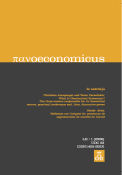A Monetary Model of Exchange Rate Beats the Random Walk Forecast Even at a Short Horizon: Evidence from the Serbian Hyperinflation at Daily Frequency
DOI:
https://doi.org/10.2298/PAN230614020PKeywords:
Monetary model of exchange rate, Out-of-sample forecast performance, Random walk forecast, Hyperinflation at daily frequencyAbstract
This paper finds that an out-of-sample forecast of a monetary model of exchange rate (MMER) in hyperinflation decisively beats a random walk one particularly at the most challenging one step ahead forecast, thus outperforming standard results previously obtained for low inflation episodes. The findings refer to the Serbian hyperinflation at daily frequency, and are robust with respect to various tests. Fast adjustment of the exchange rate to its fundamental value and the low, well below one discount factor found in the Serbian episode, as opposed to low-inflation ones, can account for divergent results in the respective inflation environments. The low discount factor appears in other hyperinflation episodes, while fast adjustment is due to the absence of nominal rigidities in hyperinflation thus both suggesting that reported findings for one episode might generalize.
JEL: F31, F47, E31.






